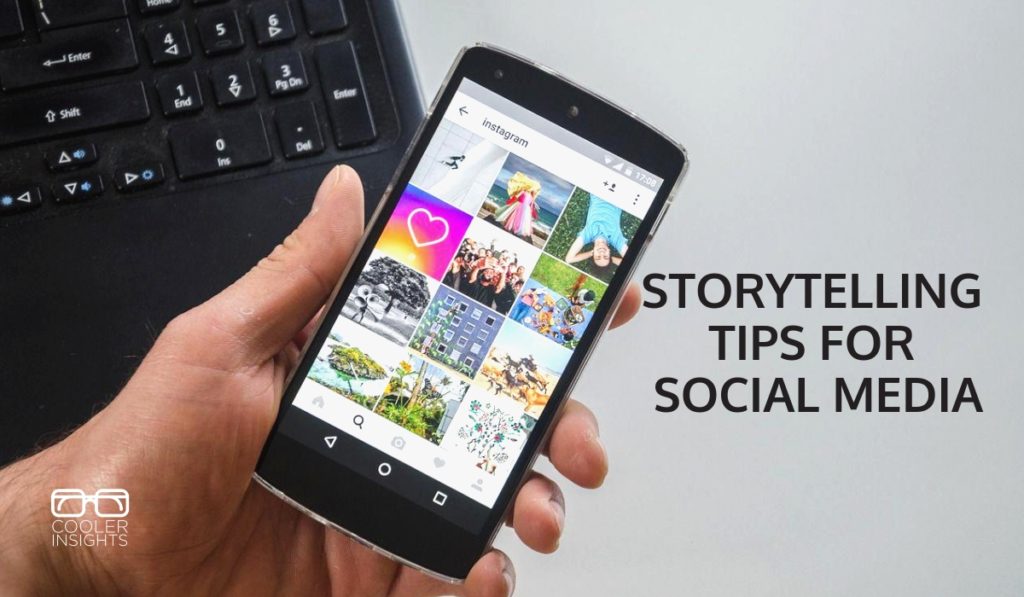
Image from Pixabay
The art and science of storytelling is a tale as old as time.
Gifted with the talent of verbal and written language, we humans have honed our storytelling techniques to perfection, spinning enchanting tales on a variety of physical and digital canvases.
With the advent of social media channels like Facebook, Instagram, Twitter, YouTube and LinkedIn, storytelling seem to have taken a decidedly new twist. It now takes centrestage in our lives, with practically every waking moment spent on creating and consuming the stories of our lives.
While the pace and duration of stories have changed (think of the 30 second Instagram video or the 144 character Tweet), the key pillars of great stories have remained the same.
These foundational tips for telling a good story are crystallized in the 6 Cs of storytelling:
- Context
- Characters
- Conflict
- Climax
- Closure
- Conclusion
Sit back, relax, and follow me as we journey through these steps.
#1 Context
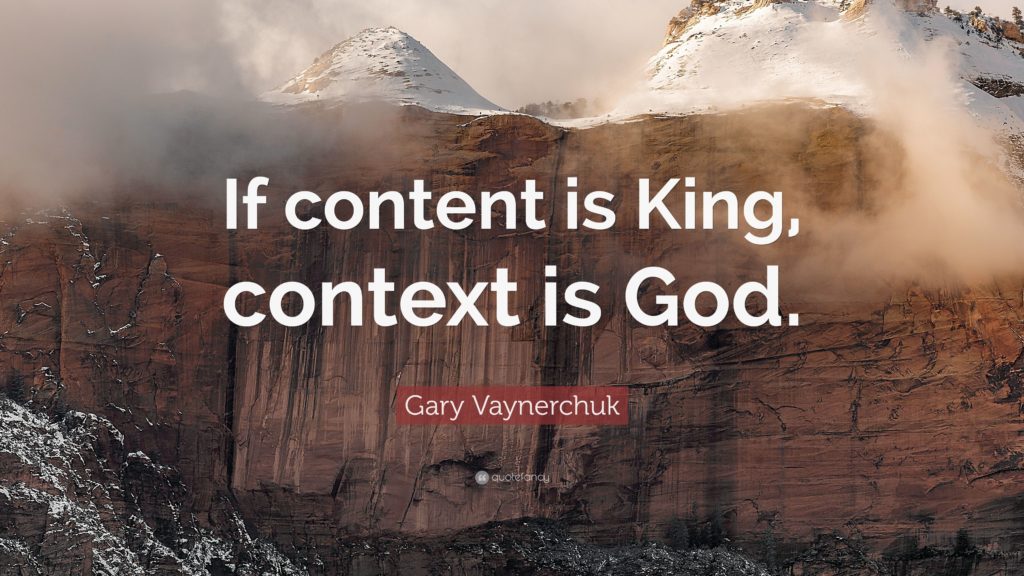
The phenomenal social media storyteller Gary Vaynerchuk once famously said the following:
“If content is king, then context is god.”
While you cannot deny the importance of a good plot in making your story come alive, understanding the context of your customers is critical in getting your story through their door.
To do so, consider the following factors.
a) Your Storytelling Audiences
This is so important, yet so often neglected. Like all other marketing strategies, social media storytelling only works if you have carefully studied the profiles of your customers.
Create a customer persona for your audience. Consider their demographics, psychographics, behaviours, needs, wants and desires.
Doing so makes it a lot easier for you to craft stories that can relevant to their needs.
b) Environmental Factors
What are the broader environmental factors surrounding your story? These may include the following:
- Geography and location
- Society and Culture
- Economy
- Technological influences
- Media
Taken as a whole, these can vastly influence how your narrative is received.
c) Timing and Seasonality
While the best stories tend to be evergreen favourites that can withstand the passage of time, most of the stories which you’ve heard, read or viewed online are likely to be ephemeral in nature. Thus, it may be useful to consider the influence of popular culture and heritage/traditions on how it is perceived.
Given the short attention span of your easily distracted audiences, you’ll need to keep your stories punchy while considering the effects of recent events or seasons.
(Read this article to learn more about context in marketing.)
#2 Characters
You can’t tell a story without characters that your audiences can relate to. And the most interesting characters in storytelling are often derived from various archetypes, like Carl Jung’s 12 common archetypes.
Let us look at some variations which you can consider.
a) Carl Jung’s 12 Character Archetypes
These are the 12 archetypes universally used to describe multiple stories, brands and individuals around the world. See if you can identify any famous personality or brand which fits into each archetype:
- Caregiver – A parental or pastoral figure who cares for your protagonist. Think Mother Teresa and Grameen Bank.
- Creator – Usually an inventive or artistic character like a musician, artist, or scientist. LEGO is a brand that fits this archetype.
- Explorer – Keen to discover herself through a journey in life, like a pilgrim, adventurer or wanderer.
- Hero – Often cast as the main protagonist, he seeks to prove his worth through courageous and heroic acts.
- Innocent – Always positive and optimistic, with a naive, dreamy and pure quality to them. Snow White would fit into this archetype like a glove.
- Jester – Fun-loving and mischievous, she loves to pull pranks like a trickster. Whoopi Goldberg and Virgin Air would fall into this archetype.
- Lover – A loyal companion who fears being unwanted or unloved. Passionate and committed, like a partner, friend or spouse.
- Magician – A visionary who is knowledgeable, charismatic and intent on finding win-win solutions. In the corporate world, Steve Jobs and Mark Zuckerberg would both qualify as magicians.
- Orphan – Wishing to belong more than anything else, she fears being left out and alone. Sometimes, she is portrayed as the girl next door or the silent majority.
- Rebel – To him, rules should be broken. Wishing to change everything that is wrong with the world, he is a revolutionary and a misfit. Han Solo from Star Wars is probably one of the best “rebel” brands out there.
- Ruler – Often cast as a boss, king, politician or ruler, he wants control and can be perceived to be authoritarian. US president Donald Trump is a clear example of such an archetype.
- Sage – Wise and reflective, the Sage seeks truth and fear ignorance. They are scholarly, philosophical and academic. Jedi Master Yoda from Star Wars and university brands like Harvard fit this archetype.
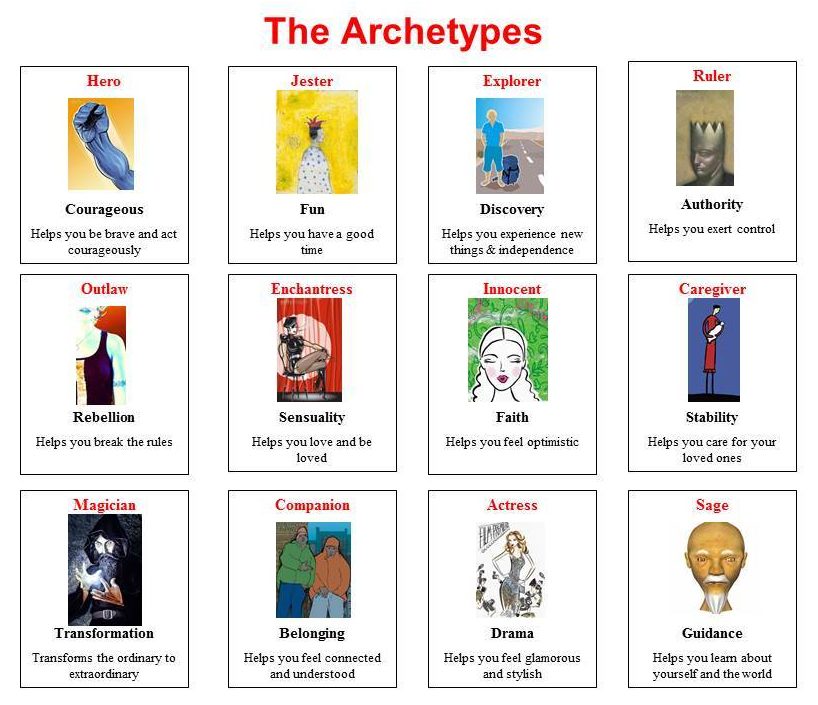
b) The Fairy-tale Model
If Jungian archetypes are too complex for you, consider the simpler fairy-tale model to build your characters.
Using metaphors that are commonly understood, they include the following characters in a story:
- The Benefactor (eg the King, company founder, or the Company itself) who is the enabler of that dream or vision.
- The Goal (eg princess and half the kingdom, premium customer service, rapid growth) which is the end objective to be reached.
- The Hero (eg prince on his white stallion, employees of the company, your customer) who needs to fulfill the quest or goal.
- The Supporter (eg good fairy or faithful squire, quality company processes) who is a person, process or organisation which assists the hero in completing his or her purpose.
- The Adversary (eg dragon or evil witch, competitor companies, problems faced by customers) who is the negative force against the goodness and values embodied by the hero.
- The Beneficiary (eg the prince on his white stallion, your customer, your client’s customers) who is the entity that will benefit by the hero achieving the quest.
c) Flat, Round, Static or Dynamic Characters
Finally, in developing your character, consider the elements of their personality as your plot unfurls:
- Flat character – usually playing a supporting role, this is a one-dimensional character.
- Round character – like a real person, this is a multi-dimensional character with a wide variety of expressions and contradictions.
- Static character – this is a character who is always the same. Often, a benefactor or a deity would be considered a static character.
- Dynamic character – often cast as the protagonist in a story, this character undergoes a major change after they’ve learned or experienced something significant.
How did you portray your story characters on social media? Are they interestingly rounded and dynamic? Or are they flat and unrelatable?
#3 Conflict
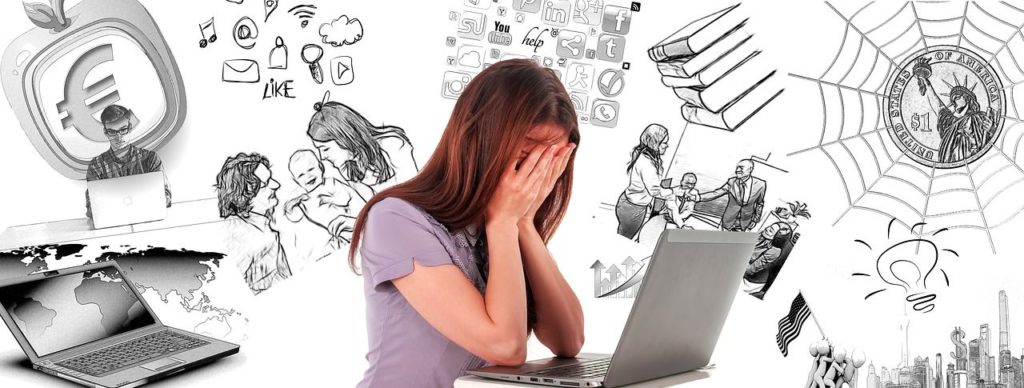
Courtesy of Pixabay
Conflict is the drama filled struggled within a character or between characters in a story.
If there is no conflict, there is no plot. If there is no plot, there is no story.
There are 4 main types of conflict which you may find in stories. Defining what these conflicts are from the onset helps you to craft a stronger plot.
- Character vs Character – This could be a battle between your protagonist and an enemy (usually another person.)
- Character vs Society – How your protagonist struggles against her community or society.
- Character vs Self – The conflict between the character and his inner self.
- Character vs Nature – The battle between the character and the forces of nature or fate.
- Character vs Technology/ Progress – How the evolution of technology made it challenging for your protagonist.
- Character vs Supernatural – Often used in fiction, it narrates the battle between your character and supernatural forces.
In the best examples of storytelling, conflicts often come in several layers. A good example is Star Wars, which covers the following types of conflicts:
- Character vs Character – Luke Skywalker vs Darth Vader/ Emperor Palpatine
- Character vs Society – Queen Amidala vs The Senate
- Character vs Self – Anakin Skywalker vs his alter ego Darth Vader
- Character vs Supernatural – Luke Skywalker vs the “Dark Side” of the Force
While your story may not be as elaborate as a space opera like Star Wars, it does help to consider at least 2 or 3 types of conflicts which your main hero would face in your story.
#4 Climax
Any story worth its salt would have a climax. Often, this culminates in an epic showdown or battle between your protagonist and her main nemesis.
In a plot of a story, this would where the peak of the action occurs. Diagrammatically, it’ll be represented like this:
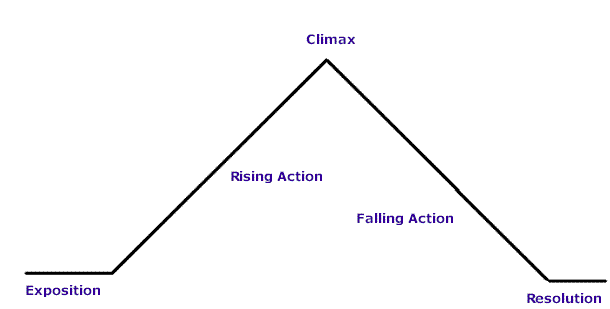
Also known as the turning point, the climax is usually the most nail-biting, chair-gripping, nerve-wracking part of the story. On social media, this could be the episode in a series of YouTube or Facebook videos where the action reaches its zenith.
Examples of climaxes in storytelling:
- Star Wars: Luke Skywalker faces Emperor Palpatine and Darth Vader in Return of the Jedi
- Harry Potter: Harry Potter faces up to Lord Voldemort in Harry Potter and the Deathly Hallows
In the Facebook series BoBo’s 3 Wishes by BoBo Fish Ball, the climax came in Episode 5 of a 6 part video series. I’m not going to spoil the fun for you, but its well worth the 30 minutes or so for you to watch all the episodes.

#5 Closure
Also known as the falling action or resolution stage in a story, closure comes from the series of events which helps you to stitch up all the loose ends of your story, and to bring the tale back to the start.
Deriving its roots from psycho-therapy, closure focuses on the need for us humans to find answers and resolve any nagging feelings we may have. In a story, it could come from mending broken relationships, healing hurts caused by emotional trauma, or restoring a kingdom back to its former glory.
Here are some examples of closure from popular culture:
- Star Wars – Darth Vader and Luke Skywalker mends their relationship after Darth Vader killed Emperor Palpatine
- Hunger Games – Katniss Everdeen liberates the Districts from the evil tyranny of President Snow
On the flip side, the lack of closure in the mysterious disappearance of Malaysian Airlines MH370 three-and-a-half years after the incident occurred made the disaster a difficult one to swallow. Even though the search for the wreckage was called off, relatives and loved ones of passengers on the plane find it difficult to move on with their lives.
#6 Conclusion
Finally, any good story should have a satisfying end to them. This should tie back to the message which you hope to communicate to your audience.
Also known as the dénouement (day-noo-mon), it is the part of the story where all plot points are solved. At this stage, the reader, listener or viewer of the story would have learned what the moral of the story is all about. Life for the characters involved would then reach a new normal.
What conclusions can you can derive from these stories (both fictitious and true?)
- President Donald J Trump wins the US presidential election
- Harry Potter and his friends vanquishes Lord Voldemort and his Deatheaters
- The tortoise wins the race
Now that we’ve come to the end of THIS story, I’d like you to ask yourself the following questions the next time you seek to craft a story:
- What are the relevant Contexts which I should take note of?
- Who are the Characters that I should weave into my story? Which archetypes should I consider?
- How should I weave Conflicts into my plot – ones that my audiences can relate to?
- When would be a good time to bring the action up to a Climax? How should this be portrayed online?
- Are there ways to bring Closure to the lives of my story characters?
- Finally, how should the Conclusion of the story be crafted so that my take home message is effectively communicated?

Yes, for me, I like to read content with storytelling rather than formal content. It’s seem you have conversation with them. Need to apply all the 6 tips for my social media. Thank you.